
Looking for How to Make Cherry Jam or Cherry Preserves - Easily! With Step-by-step Directions, Photos, Ingredients, Recipe and Costs in 2025? Scroll down this page and follow the links. And if you bring home some fruit or vegetables and want to can, freeze, make jam, salsa or pickles, see this page for simple, reliable, illustrated canning, freezing or preserving directions. There are plenty of other related resources, click on the resources dropdown above. If you are having a hard time finding canning lids, I've used these, and they're a great price & ship in 2 days.
If you have questions or feedback, please let me know! There are affiliate links on this page. Read our disclosure policy to learn more.
How to Make Cherry Jam or Cherry Preserves - Easily! With Step-by-step Directions, Photos, Ingredients, Recipe and Costs
Yield: 3 pint jars or 6 eight-ounce jars
Click here for a Pdf print version
Making and canning your own cherry jam or cherry preserves is also quite easy. The subtle differences is cherry jams tend to be more smooth and the fruit is more finely chopped or group, while cherry preserves have more whole fruit pieces.Just scroll down this page to see how to do it, in easy steps and completely illustrated. These directions work equally well for other small pitted fruits.
- See this page to make Cherry jelly
- For information about cherry festivals, see the cherry festivals page.
- Update for 2019: if you find any typos or inconsistencies, let me know. A blogger complained but I'll be darned if I see anything wrong!
Ingredients
- Cherries - 3 pounds or 4 cups of chopped, pitted fresh cherries (which takes about 2 quart boxes of fresh whole cherries). Frozen cherries (without syrup works, too). You can use either sour or sweet cherries.
- Pectin (it's a natural product, made from apples and available at grocery stores (season - spring through late summer) and local "big box" stores. It usually goes for about $2.00 to $2.50 per box. You will get best results with no-sugar needed pectin, whether you choose to add sugar or not! I use 1.25 boxes per batch - that's right one and another quarter of a box. See here for more information about how to choose the type of pectin to use.
- Lemon juice - 2 tablespoons - for sweet cherry jam, not needed with sour cherries.
- Sugar - About 2.5 cups of dry, granulated (table) sugar with sweet cherries or 4 cups of sugar if you are using sour cherries. If you use the no-sugar pectin, you can make jam without added sugar, or with Stevia, my preference (or if you prefer, Splenda), but see my note in step about how it affects the jam
Equipment
- Jar funnel ($5 at Target, other big box stores, and often grocery stores; and available online - see this page) or order it as part of the kit with the Jar grabber .
- At least 1 large pot; I prefer 16 to 20 quart Nonstick ceramic coated pots for easy cleanup.
-
See here for related tools, equipment, supplies on Amazon See here for related tools, equipment, supplies on Amazon See here for related tools, equipment, supplies on AmazonCherry pitter: without one of these, it's pretty hard to remove the pits from a fresh cherry.
I'm trying this Norpro pitter out right now. Reviewers say it can handle larger volumes of cherries reliably!
Comments from a visitor on July 1, 2010: "I wanted to let you know about the Norpro Deluxe Cherry Stoner/Pitter. These things are GREAT!!! They pit cherries reliably and remarkably fast! Just tell your readers to NOT lose the orange inserts (they may be other colors now) that come with the cherry pitter. They're definitely necessary to actually pit the cherries."
- Large spoons and ladles,
- 1 Water Bath Canner (a huge pot to sanitize the jars after filling (about $30 to $35 at mall kitchen stores, sometimes at big box stores and grocery stores.). Note: we sell canners and supplies here, too - at excellent prices - and it helps support this web site!
- Ball jars (Grocery stores, like Publix, Kroger, Safeway carry them, as do some big box stores - about $7 per dozen 8 ounce jars including the lids and rings)
- Lids - thin, flat, round metal lids with a gum binder that seals them against the top of the jar. They may only be used once.
-
Jar grabber
(to pick up the hot jars)- Big box stores and grocery stores sometimes carry them; and it is available online - see this page. It's a tremendously useful to put jars in the canner and take the hot jars out (without scalding yourself!). The kit sold below has everything you need, and at a pretty good price:
- Rings - metal bands that secure the lids to the jars. They may be reused many times.
Optional stuff:
- Cherry pitters - These two work great (I tested both):
- Lid lifter (has a magnet to pick the lids out of the almost-boiling water where you sanitize them. ($4 at big box stores or it comes in the kit at left)
Cherry Jam-making Directions
Step 1 - Pick the cherries! (or buy them already picked)
It's fun to go pick your own and you can obviously get better quality ones!
As mentioned in the Ingredients section; you may use frozen
cherries (those without syrup or added sugar); which is especially useful if you want to make some jam in December to give away at Christmas!
How much fruit?
You will need about 4 cups of finely chopped, pitted cherries (which is about 3 pounds or 2 quart boxes of fresh whole cherries). You can use sweet or sour cherries, but obviously, you will need to add more sugar with sour cherries to overcome the sourness!
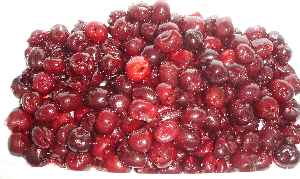 Jam can ONLY be made in rather small batches - about
4 cups at a time - like the directions on the pectin say, DO NOT increase the
recipes or the jam won't "set" (jell, thicken). (WHY? Alton Brown on the
Food Channel says pectin can overcook easily and lose its thickening properties.
It is easier and faster to get an even heat distribution in smaller batches.
Jam can ONLY be made in rather small batches - about
4 cups at a time - like the directions on the pectin say, DO NOT increase the
recipes or the jam won't "set" (jell, thicken). (WHY? Alton Brown on the
Food Channel says pectin can overcook easily and lose its thickening properties.
It is easier and faster to get an even heat distribution in smaller batches.
Step 2 - Wash the jars and lids
The yield from this recipe is about 6 eight-ounce jars (which is the same as 3 pints).
 Now's a good time to get the jars ready, so you won't be rushed later. The dishwasher is fine for the jars; especially if it has a "sanitize" cycle, the water bath processing will sanitize them as well as the contents! If you don't have a dishwasher with a sanitize cycle, you can wash the containers in hot, soapy water and rinse, then sanitize the jars by boiling them 10 minutes, and keep the jars in hot water until they are used.
Now's a good time to get the jars ready, so you won't be rushed later. The dishwasher is fine for the jars; especially if it has a "sanitize" cycle, the water bath processing will sanitize them as well as the contents! If you don't have a dishwasher with a sanitize cycle, you can wash the containers in hot, soapy water and rinse, then sanitize the jars by boiling them 10 minutes, and keep the jars in hot water until they are used.
NOTE: If a canning recipe calls for 10 minutes or more of process time in the canner, then the jars do not need to be "sanitized" before filling them. But really, sanitizing them first is just good hygiene and common sense! See this page for more detail about cleaning and sanitizing jars and lids.
Put the lids into a pan of hot, but not quite boiling water (that's what the manufacturer's recommend) for 10 minutes, and use the magnetic "lid lifter wand" to pull them out. Leave the jars in the dishwasher on "heated dry" until you are ready to use them. Keeping them hot will prevent the jars from breaking when you fill them with the hot jam.
Step 3
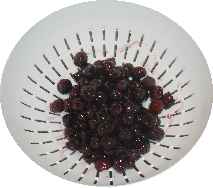 -Wash and
pit the fruit!
-Wash and
pit the fruit!
I'm sure you can figure out how to wash the fruit in plain cold water.
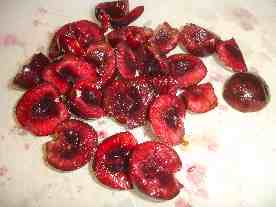 With
cherries you must remove the pits. There are inexpensive cherry pitters that
work fine for occasional use, or larger more sophisticated pitters if you're
going to be doing a lot. As with other fruit, also pick out any stems and leaves.
With
cherries you must remove the pits. There are inexpensive cherry pitters that
work fine for occasional use, or larger more sophisticated pitters if you're
going to be doing a lot. As with other fruit, also pick out any stems and leaves.
Pit the fresh cherries, and keep them in cold water with 1/4 lemon juice add (to
prevent browning)
.
A cherry pitter is inexpensive and easy to use, once you learn the trick. The goal is to push down so the metal stem holds the pit down against the opening in the bottom of the cup. The pits will not go through the hole; it is just to help trap them. then releasing your grip, the cherry rides up on the metal stem, while the pit remains trapped in the cup, stuck in the hole. Then just push the cherry off and use your thumb on the underside of the cup, to push the pit back out.
See here for related tools, equipment, supplies on Amazon
Now, if you absolutely can't get hold of a cherry pitter... I think you could heat the cherries to a boil, then run them through a Foley food mill or other strainer, to separate the pits from the cherries. I haven't tried it, but that ought to be easier than manually pitting cherries with a knife.
Step 4 -
Finely chop or grind the cherries
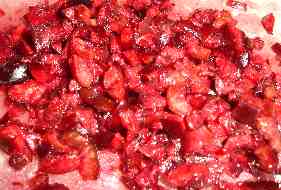
For cherry jam, you will want to either finely chop the cherries or grind them (a Foley Food Mill will work for the latter). I've tried just pitting the cherries, but leaving them mostly whole, and it just doesn't turn out as well. Even to make cherry preserves, you need to pit and chop them up some. Otherwise, you get whole cherries suspended in a sugar solution rather than a consistent jam. just mush them up a bit - not completely crushed, but mostly. Also, chopping, grinding or crushing them releases the natural pectin so it can thicken. You will need about 4 cups, chopped up.
The Foley food mills (at right) cost about $30.
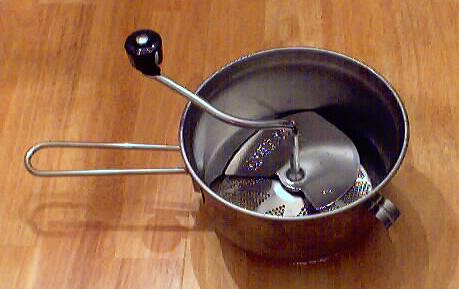
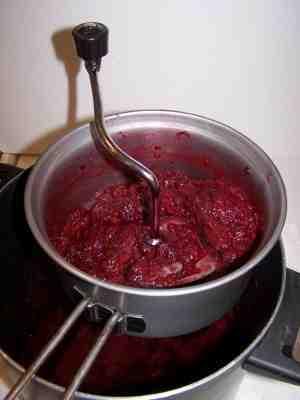
See here for related tools, equipment, supplies on Amazon
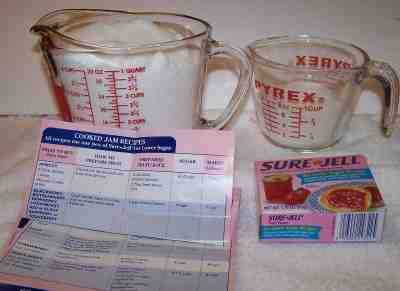
Step 5 - Measure out the sugar
If you are using the no-sugar pectin, you can avoid adding any sugar, OR you can add Stevia, my preference (or if you prefer, Splenda) to taste, or plain sugar, to taste. I generally add about 2.5 cups of sugar to sweet cherries or 4 cups to sour cherries. It seems to give the best results. The no-sugar or Stevia, my preference (or if you prefer, Splenda) versions just don't have the bright color and the flavor is definitely more bland. You can try using 1 cup of white grape juice instead of sugar - that works better than no sugar, but I still think sugar works best.
Mix the 1 and a quarter boxes of dry pectin with about 1/4 cup of the sugar and Keep this separate from the rest of the sugar. If you are not using sugar, you will just have to stir more vigorously to prevent the pectin from clumping. This helps to keep the pectin from clumping up and allows it to mix better!
Step 6 - Mix the chopped cherries with the pectin and cook to a full boil
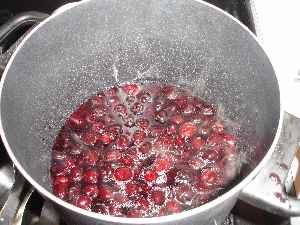 Stir the pectin into the
chopped up cherries and put the mix in a big pot on the stove over medium to high heat (stir often enough to prevent burning). It should take about 5 to 10 minutes to get it to a full boil (the kind that cannot be stirred away).
NOTE
: you can add 2 Tablespoons of lemon juice (fresh or bottled) if you
are using sweet cherries, to help make it more acid, which helps to prevent
spoilage and makes the color brighter. This is not necessary with sour cherries
which are naturally more acidic.
Stir the pectin into the
chopped up cherries and put the mix in a big pot on the stove over medium to high heat (stir often enough to prevent burning). It should take about 5 to 10 minutes to get it to a full boil (the kind that cannot be stirred away).
NOTE
: you can add 2 Tablespoons of lemon juice (fresh or bottled) if you
are using sweet cherries, to help make it more acid, which helps to prevent
spoilage and makes the color brighter. This is not necessary with sour cherries
which are naturally more acidic.
Why use pectin? You may run into grandmotherly types who sniff " I never used pectin!" at you. Well, sure, and their generation took a horse and buggy to work, died of smallpox and ate canned meat and green beans that tastes like wet newspapers. Old fashioned ways are not always better nor healthier. Pectin, which occurs naturally in fruit, is what makes the jam "set" or thicken. The pectin you buy is just natural apple pectin, more concentrated. Using pectin dramatically reduces the cooking time, which helps to preserve the vitamins and flavor of the fruit, and uses much less added sugar. But, hey, if you want to stand there and stir for hours, cooking the flavor away, who am I to stop you! :) Having said that, there are some fruits that have naturally high amounts of pectin ( see this page for a list ) and they simply don't need much or even any padded pectin.
Notes about pectin:
I usually add about 25% more pectin (just open another pack and add a little) or else the jam is runnier than I like. With a little practice, you will find out exactly how much pectin to get the thickness you like.
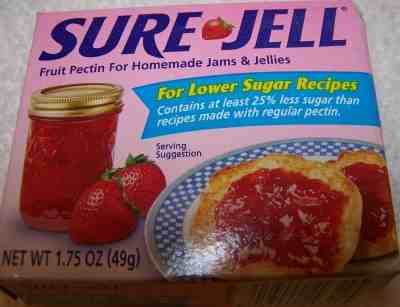
Another tip: use the lower sugar or no-sugar pectin. You can add sugar to either and it cuts the amount of sugar you need from 7 cups per batch to as little as 2.5 cups! And it tastes even better! On the other hand; as I said earlier, I have never had success with the No-sugar pectin without adding ANY sugar. It always turned out runny and bland. You might want to try using the low sugar or no-sugar recipe with a mixture of sugar and Stevia, my preference (or if you prefer, Splenda); sugar and white grape juice, or just white grape juice - that will cut down the sugar, but still preserve the flavor.

Is your jam too runny? Pectin enables you to turn out perfectly set jam every time. Made from natural apples, there are also natural no-sugar pectins that allow you to reduce the sugar you add by half or even eliminate sugar.!
Get it here at BETTER prices!
Step 7 - Get the lids warming in hot (but not boiling) water

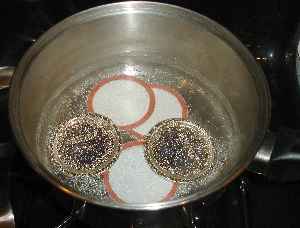 Lids: put the lids into a pan of hot water for at least several minutes; to soften up the gummed surface and clean the lids.
Lids: put the lids into a pan of hot water for at least several minutes; to soften up the gummed surface and clean the lids.

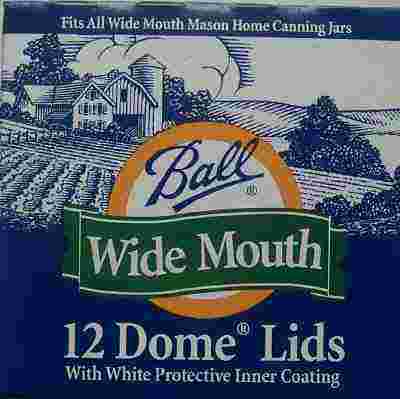
Need lids, rings and replacement jars?
Get them all here, delivered direct to your home, at the best prices on the internet!
Step 8 - Add the remaining sugar and bring to a boil again for 1 minute
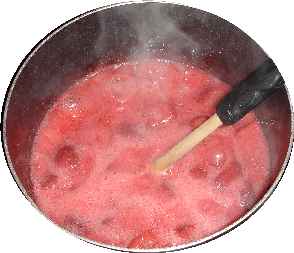
When the berry-pectin mix has reached a full boil, add the sugar and then bring it back to a boil and boil hard for 1 minute... If you bring it back to a full boil fairly slowly (on medium heat rather than high) that will help reduce foaming.
Remove from the heat.
Step 9 - Skim any excessive foam
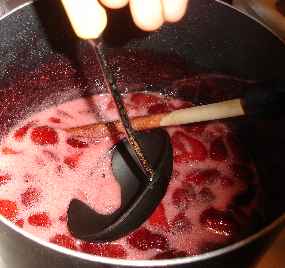 Foam... What is it? Just jam with a lot of air from the boiling.
Foam... What is it? Just jam with a lot of air from the boiling.
 But it tastes more like, well, foam, that jam, so most people remove it. It is harmless, though. Some people add 1 teaspoon of butter or margarine to the mix in step 6 to reduce foaming, but food experts debate whether that may contribute to earlier spoilage, so I usually omit it and skim.
But it tastes more like, well, foam, that jam, so most people remove it. It is harmless, though. Some people add 1 teaspoon of butter or margarine to the mix in step 6 to reduce foaming, but food experts debate whether that may contribute to earlier spoilage, so I usually omit it and skim.
But save the skimmed foam! You can recover jam from it to use fresh! See this page for directions!
Step 10 - Testing for "jell" (thickness)
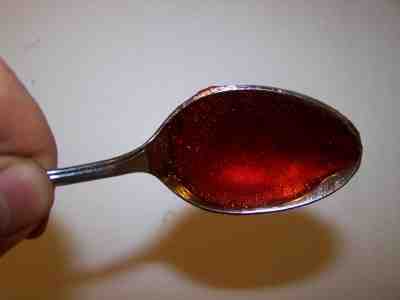 I keep a metal tablespoon sitting in a glass of ice water, then take a half spoonful of the mix and let it cool to room temperature on the spoon. If it thickens up to the consistency I like, then I know the jam is ready. If not, I mix in a little more pectin (about 1/4 to 1/2 of another package) and bring it to a boil again for 1 minute.
I keep a metal tablespoon sitting in a glass of ice water, then take a half spoonful of the mix and let it cool to room temperature on the spoon. If it thickens up to the consistency I like, then I know the jam is ready. If not, I mix in a little more pectin (about 1/4 to 1/2 of another package) and bring it to a boil again for 1 minute.
Notes about "set" (thickening or jell): It takes 3 ingredients for jams and jellies to set: pectin, sugar and acidity. The amount of pectin that is naturally occurring in the fruit varies from one type of fruit to another and by ripeness (counter intuitively, unripe contains more pectin). See this page for more about pectin in fruit. It takes the right balance, and sufficient amounts of each of pectin, sugar and acidity to result in a firm jam or jelly. Lastly, it takes a brief period (1 minute) of a hard boil, to provide enough heat to bring the three together. Generally speaking, if your jam doesn't firm up, you were short in pectin, sugar or acidity or didn't get a hard boil. That's ok - you can "remake' the jam; see this page !
Step 11 - Floating fruit?.
The fruit will often float to the top of the jar. This isn't a particular problem; you can always stir the jars later when you open them; but some people get fussy about everything being "just so", just keep in mind that you can either give it a quick stir now, or 24 hours later invert the jars.
You will also notice that the less sugar you use, the more the fruit will float (chemists will tell you it is due to the decreased density of the solution!)
 Step 12 - Fill the jars and put the lid and rings on
Step 12 - Fill the jars and put the lid and rings on
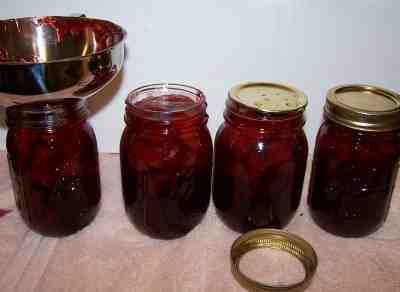 Fill them to within 1/4-inch of the top, wipe any spilled jam off the top, seat the lid and tighten the ring around them. Then put the filled jars into the canner!
Fill them to within 1/4-inch of the top, wipe any spilled jam off the top, seat the lid and tighten the ring around them. Then put the filled jars into the canner!

This is where the jar tongs come in really handy!
Step 13 - Process the jars in the boiling water bath
Keep the jars covered with at least 2 inches of water. Keep the water boiling. In general, boil them for 10 minutes, which is what SureJell (the makers of the pectin) recommend. I say "in general" because you have to
 process (boil) them longer at higher altitudes than sea level, or if you use larger jars, or if you did not sanitize the jars and lids right before using them. The directions inside every box of pectin will tell you exactly. The directions on the pectin tend to be pretty conservative. Clemson University says you only need to process them for 5 minutes. I usually hedge my bets and start pulling them out after 5 minutes, and the last jars were probably in for 10. I rarely have a jar spoil, so it must work. But you don't want to process them too long, or the jam will turn dark and get runny. See the chart below for altitude adjustment to processing times, if you are not in the sea level to 1,000ft above sea level range.
process (boil) them longer at higher altitudes than sea level, or if you use larger jars, or if you did not sanitize the jars and lids right before using them. The directions inside every box of pectin will tell you exactly. The directions on the pectin tend to be pretty conservative. Clemson University says you only need to process them for 5 minutes. I usually hedge my bets and start pulling them out after 5 minutes, and the last jars were probably in for 10. I rarely have a jar spoil, so it must work. But you don't want to process them too long, or the jam will turn dark and get runny. See the chart below for altitude adjustment to processing times, if you are not in the sea level to 1,000ft above sea level range.
Note: Some people don't even boil the jars; they just ladle it hot into hot jars, put the lids and rings on and invert them, but putting the jars in the boiling water bath REALLY helps to reduce spoilage! To me, it makes little sense to put all the working into making the jam and then not to process the jars to be sure they don't spoil!
|
Recommended process time for jams in a boiling water canner . |
||||
| Process Time at Altitudes of | ||||
| Style of Pack | Jar Size | 0 - 1,000 ft | 1,001 - 6,000 ft | Above 6,000 ft |
| Hot | Half-pints
or Pints |
5 min | 10 | 15 |
Step 14 - Remove and cool the jars - Done !
 Lift the jars out of the water with your jar lifter tongs and let them cool without touching or bumping them in a draft-free place (usually takes overnight) You can then remove the rings if you like, but if you leave them on, at least loosen them quite a bit, so they don't rust in place due to trapped moisture. Once the jars are cool, you can check that they are sealed verifying that the lid has been sucked down. Just press in the center, gently, with your finger. If it pops up and down (often making a popping sound), it is not sealed. If you put the jar in the refrigerator right away, you can still use it. Some people replace the lid and reprocess the jar, then that's a bit iffy. If you heat the contents back up, re-jar them (with a new lid) and the full time in the canner, it's usually ok.
Lift the jars out of the water with your jar lifter tongs and let them cool without touching or bumping them in a draft-free place (usually takes overnight) You can then remove the rings if you like, but if you leave them on, at least loosen them quite a bit, so they don't rust in place due to trapped moisture. Once the jars are cool, you can check that they are sealed verifying that the lid has been sucked down. Just press in the center, gently, with your finger. If it pops up and down (often making a popping sound), it is not sealed. If you put the jar in the refrigerator right away, you can still use it. Some people replace the lid and reprocess the jar, then that's a bit iffy. If you heat the contents back up, re-jar them (with a new lid) and the full time in the canner, it's usually ok.
If you invert the jars when they are still warm, but the lids have sealed (usually about 10 - 12 hours later) that will help to reduce floating fruit.
Once cooled, they're ready to store. I find they last up to 12 months. But after about 6 to 8 months, they get darker in color and start to get runny. They still are safe to eat, but the flavor and texture aren't as good. So eat them in the first 6 months after you prepare them! Another trick is to keep the uncooked cherries or other fruit in the freezer and make and can the jam as needed, so it's always fresh.
Summary - Typical Cost of Making Homemade Cherry Jam - makes 6 jars, 8 oz each** |
||||
|
Item |
Quantity |
Cost in 2025 |
Source |
Subtotal |
|
Cherries, fresh |
3 pounds or 2 quart boxes of fresh whole cherries |
$2.00/lb |
Pick your own |
$6.00 |
|
Canning jars (8 oz size), includes lids and rings |
18 jars |
$11/dozen 8 oz jars |
WalMart, BigLots, |
$10.00 |
|
Sugar |
2.5 to 4 cups, depending upon your taste and the type of pectin you use. |
$2.00 |
WalMart, BigLots, |
$2.00 |
|
Pectin (no sugar, dry) |
1 and a quarter boxes * |
$2.00 per box |
WalMart, BigLots, |
$2.50 |
|
Total |
|
|
|
$17.50 total |
|
** - This assumes you already have the pots, pans, ladles,, and reusable equipment. Note that you can reuse the jars and reduce the cost further; just buy new lids (the rings are reusable, but the flat lids are not)! |
||||
FAQs - Answers to Common Questions
- As my jars are cooling after i take them out of the canner, they
sometimes make a popping or hissing noise. Is this normal and
safe?
Yes, the lids are designed to flex and that's actually a key selling point. You can tell if a jar hasn't sealed properly (after it has cooled completely) if the lid flexes and makes a popping sound when you press the center of the lid with your finger. The popping sounds while it is cooling is the lid being sucked down by the vacuum that is forming inside the jar - which a normal part of the sealing process. Hissing sounds are usually just escaping steam or hot water evaporating on hot surfaces, also normal! - Why should cooked jelly be made in
small batches?
If a larger quantity of juice is used, it will be necessary to boil it longer thus causing loss of flavor, darkening of jelly, and toughening of jelly. It really doesn't work. Trust me; I've tried many times! - Can I use frozen cherries instead of
fresh?
Yep! Raspcherries can be particularly hard to find fresh and are expensive! Frozen cherries work just fine, and measure the same. Just be sure to get the loose, frozen whole fruit; not those that have been mushed up or frozen in a sugar syrup! - Should jelly be boiled slowly or
rapidly?
It should be boiled rapidly since long, slow boiling destroys the pectin in the fruit juice. - What do I do if there's mold on my
jellied fruit product?
Discard jams and jellies with mold on them. The mold could be producing a mycotoxin (poisonous substance that can make you sick). USDA and microbiologists recommend against scooping out the mold and using the remaining jam or jelly. - Why did my jellied fruit product
ferment, and what do I do?
Jellied fruit products may ferment because of yeast growth. This can occur if the product is improperly processed and sealed, or if the sugar content is low. Fermented fruit products have a disagreeable taste. Discard them. - What happens if my jam or jelly
doesn't gel?
Remaking cooked runny jam or jelly instructions can be found on this page - What is the best way to deseed cherries
for jam? I heard a few different ways. A food mill, a ricer, and cheese
cloth.
For large seeds (blackcherries, apples, and larger) I find a Foley Food Mill works best - it's certainly faster and easier than the other methods. Raspberry and smaller seeds are a real pain. They get stuck in (and clog) or pass through a food mill. Cheesecloth and jelly strainers are messy, take forever and you lose most of the pulp. For these, I find a metal sieve or colander (with small enough holes) and a spatula to help mush them and push the pulp through, is best. Also, heating the mushed up cherries almost to boiling really helps to separate the seeds and pulp.
Other Equipment:From left to right:
|

You can get all of the tools in a kit here: See here for related tools, equipment, supplies on Amazon
|
Looking for canning equipment and supplies?
Water bath canner with a jar rack
Pressure canners for gas, electric and induction stoves: Presto 23Qt or T-fal 22Qt
Canning scoop (this one is PERFECT)
Ball Blue book (most recent version)
Jars: 8oz canning jars for jams
Find Other types of farms:
Farm markets and roadside stands
Road trips and camping resources
Local Honey, apiaries, beekeepers
Consumer fraud and scams information
Home canning supplies at the best prices on the internet!
Maple Syrup Farms, sugarworks, maple syrup festivals
Environmental information and resources
Farms For Your Event for birthday parties, weddings, receptions, business meetings, retreats, etc.
Festivals - local fruit and vegetable festivals
Get the
most recent version of
the Ball Blue Book
With this Presto 23 quart pressure canner and pressure cooker, you can "can" everything, fruits, vegetables, jams, jellies, salsa, applesauce, pickles, even meats, soups, stews. Model 01781

You can make jams, jellies, can fruit, applesauce, salsa and pickles with water bath canners, like this Granite Ware 12-Piece Canner Kit, Jar Rack, Blancher, Colander and 5 piece Canning Tool Set

